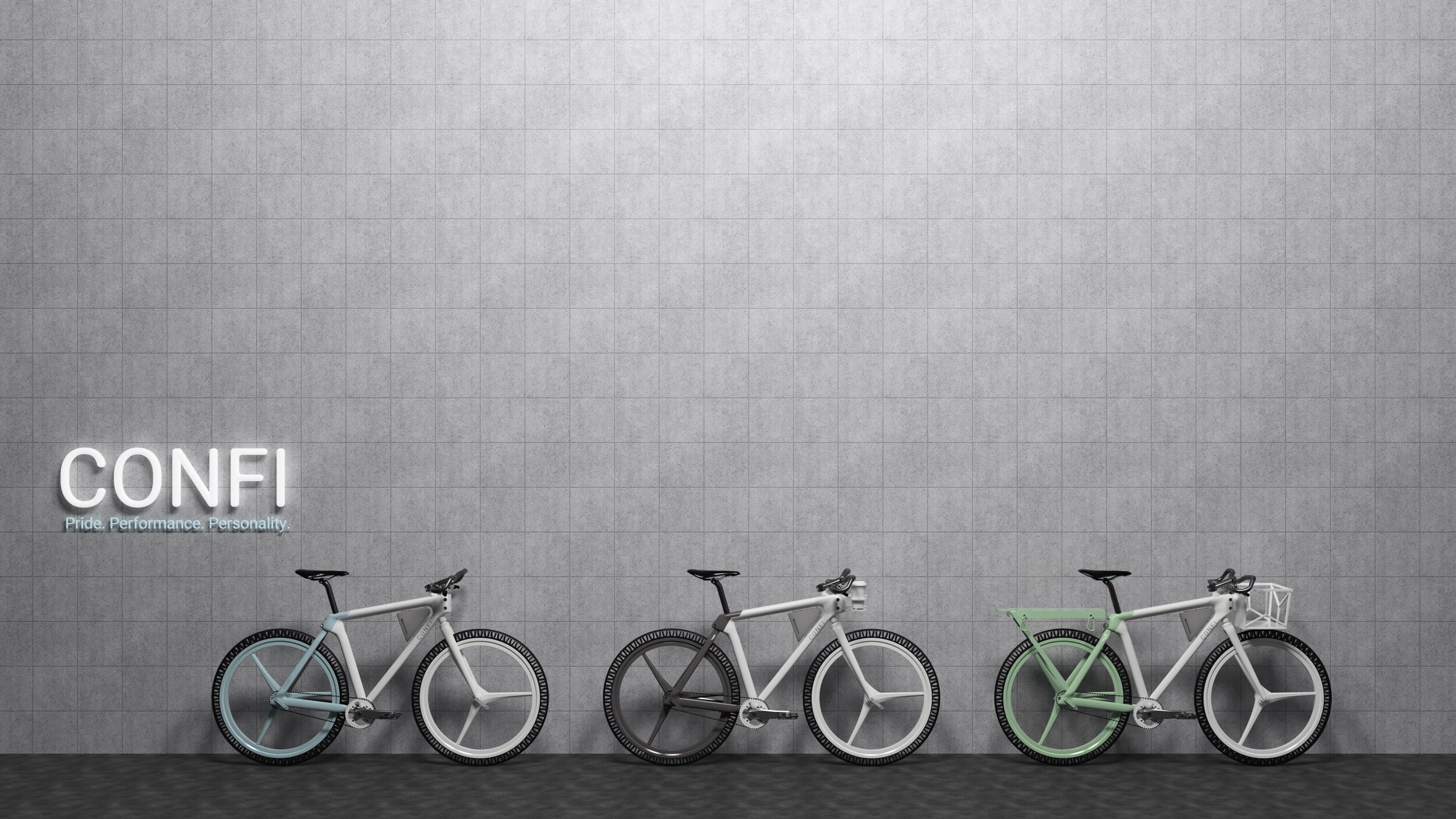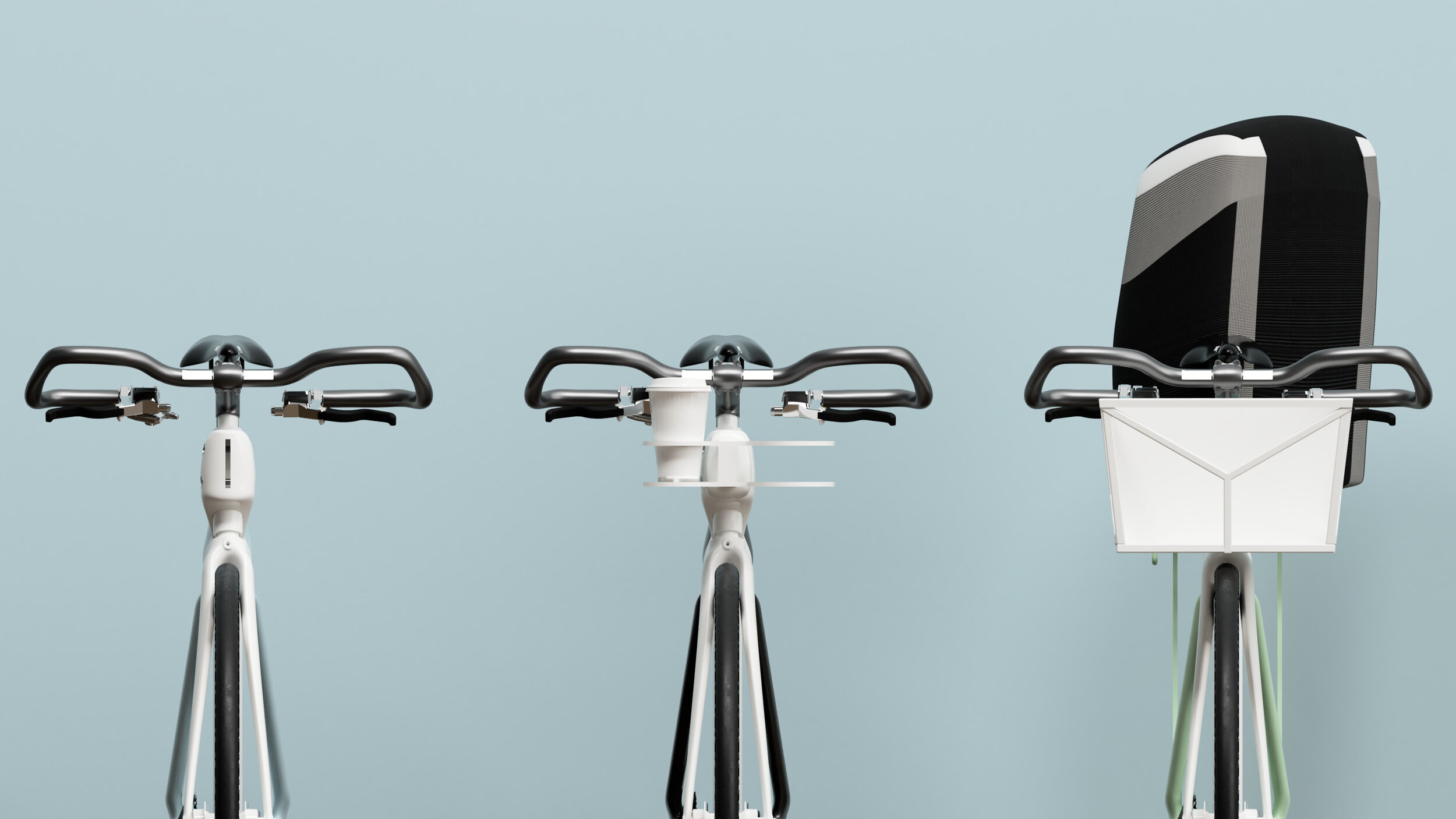
Gold Industry Award Winner - Launchpad Plus 2018 - Georgia Tech School of Industrial Design
Problem
Innovate on the commuter bike experience, incorporating tweel technology and IoT, when appropriate.
Solution
CONFI is a bike designed for commuter cyclists with pride, performace, and personality in mind. Created from a modular system of cohesive parts, CONFI is easily adaptable to suit its user’s daily, weekly, or casual needs.
DATE
Jan 2018 - May 2018
TOOLS
Autodesk Fusion 360, Adobe CC 2018, KeyShot, CNC Router, Various Rapid Prototyping Tools
CLIENTS
Michelin // Autodesk Fusion 360
— Pride.
CONFI prides itself on user-centered design, so riders can take pride in their CONFI bike in return. Every step of our design process allows our riders to personalize their bike to their heart’s content, beginning at color choice and extending to our diverse selection of interchangeable attachments.
— Performance.
With an attachment to suit every rider’s wants and needs, durable tweel technology, quick release wheels, and an easily serviceable belt drive, CONFI provides sophisticated performance with efficiency and ease. Whether our riders are carrying cell phones, water bottles, or backpacks, they enjoy safety and durability without sacrificing comfort.
— Personality.
Cyclists consider their bike to be an extension of themselves. CONFI’s custom paint colors and cohesive system of attachments come together to allow the rider to imbue their chosen form of transportation with their personal flare. So whether you’re a minimalist, a coffee fanatic, or a utilitarian, CONFI can adapt to your needs in style.

— UX Research
We began by conducting extensive user research to understand what cyclists wanted and needed from their bikes. We employed a variety of research methods, including:
Observations | User Survey | User Journey Recordings | User Interviews | Voice of the Consumer Map
We also analyzed a significant amount of research on bicycles, going through design thinking processes to highlight issues and features of specific interest in our pursuit to design a commuter bike.
Learn.
Bikes are complex innovations. We made sure to do our homework on bike history and anatomy so we could understand the people we were designing for.
Survey.
Who are commuter cyclists? What are their wants, needs, and pain points? We asked the cycling community and received over 100 responses from a diverse group of people.
Observe.
How do commuters customize their bikes? What steps do they take before and after riding? We walked around and had a look for ourselves.
Record.
What does a commute by bike look like? What are some obstacles commuters face? We asked a group to record their experiences to see the world through their eyes.
Interview.
Conducting interviews with a diverse group of commuter cyclists was important to begin qualitatively understanding the wants, needs, and pain points of commuting.
Distill.
At the end of our research phase, we were left with a lot of qualitative and quantitative data points and began distilling our findings into insights.
— Insights.
Safety & Security.
As commuters, our users often ride on busy roads and are concerned for their safety. They want their bikes to be durable and easily serviceable to give them peace of mind on their rides.
Customization.
Commuter cyclists take a significant amount of time customizing their bikes to fit their specific needs. They often carry backpacks, water bottles, and first aid kits, and need the option to accommodate their belongings.
Connection.
Interestingly, we discovered cyclists go through a profound personal journey designing their bikes. So much so, their transportation becomes a reflection of their personality and an immense source of pride.
“A bike is more than 2 wheels and a frame.”
-CONFI insight
Cyclists, regardless of their demands as a commuter, imbue their bike with their personality. It’s an extension of themselves. They each took pride in how they customized their bike, whether that meant being solely concerned with the aesthetic of the bike itself, or focusing on accessorizing it and making it as functional as possible.
Keeping this insight in mind, we decided to create a product that was more of a system of interchangeable parts, to maximize customizability while maintaining a unified brand and design.
— Ideation.
Based on our research and insights, we centered our ideation efforts around the concept of modularity and individual customization. We began exploring the idea of creating a system through interchangeable attachments, examining color, lighting, and function.
Ultimately, we narrowed our focus to creating a rear attachment point for interchangeable stays and a front attachment point for various small accessories.




— Prototyping.
Early prototyping efforts began in Autodesk Fusion 360. CAD Modeling was utilized to provide dimension to our concepts. In order to grasp scale, we moved into VR testing. This stage was critical for determining fitment and ergonomics to enable us to adjust any proportion issues in our model before moving into construction.
— Refinement.
Start to finish, CONFI went through dozens of iterations. Color exploration, frame variations, hub and tweel iterations, and the incorporation of different accessories were all part of the design process getting to the final version. Check out the time-lapse here to see some of the work behind it all.
— Construction.
Upon completion of digital modeling, we moved into construction of a full-scale physical model. Initial CAM programming was completed to create a custom frame and wheels via CNC router.
Various modular attachments and connection points were created from 3D prints and laser-cut acrylic. Once all individual components were glued, painted, and finessed, the full bike was assembled, accessories were added, and finishing branding was applied.

— CONFI.
The final product was a minimalist frame characterized by contrasting interchangeable stays and front attachments. By developing modular assets, consumers could purchase a specific attachment based on their needs, or multiple if they required more adaptability in their lives.
Attachments:
Durable Safety Pouch — Two-size Cup Holder — Back Rack with Adjustable Tie Down — Weather-resistant Front Basket
Detachable Stays.
The rear modular attachment was made as easily interchangeable as possible, utilizing hex bolts detachable via a standard allen wrench and an easily removeable belt drive. This makes it easier and significantly quicker for cyclists with only a basic knowledge of maintenance to service their bike.
Safety First.
Modern tweel technology was incorporated to extend the life of our commuters’ tires. Standard air-filled tires can flatten over time or with a simple puncture. Tweels are more durable and won’t unexpectedly deflate, ensuring commuters can arrive at their destinations safely and on time.
Modular Front.
A modular front attachment was included on the bike for added functionality in the form of a cup holder or front basket for added storage. A detachable theft-resistant safety pouch was also designed into the bike, to enable lighter travel and assuage fears of losing valuables.
— Exhibit.
Our final display functioned as a small pop-up boutique to showcase CONFI. The bike was juxtaposed against a branded wall with an illuminated logo for added effect. To accessorize the bike, we featured a back rack and cup holder.
The display was accompanied by a coffee cart and doughnuts for our audience. And yes, we did have real coffee! I functioned as the in-house barista for the day, hand-grinding beans and making fresh pour-overs when needed. We wore custom designed t-shirts to represent the CONFI brand, each a color of our choosing to show our personality.
CONFI Pop-Up
Following the completion of CONFI, we designed an accompanying pop-up shop and branded experience. Between a pop-up coffee bar, interactive floor showcase, and augmented reality design experience, we hope you’ll stop by!



















